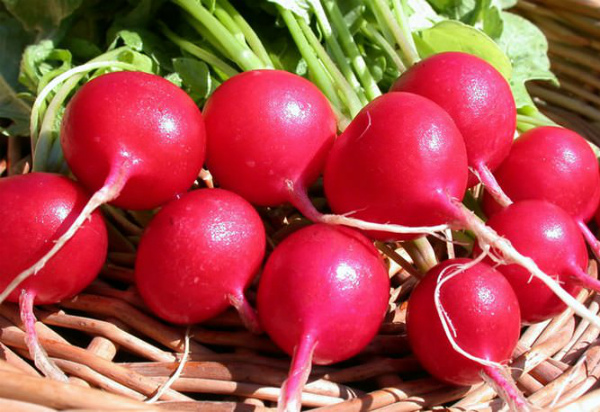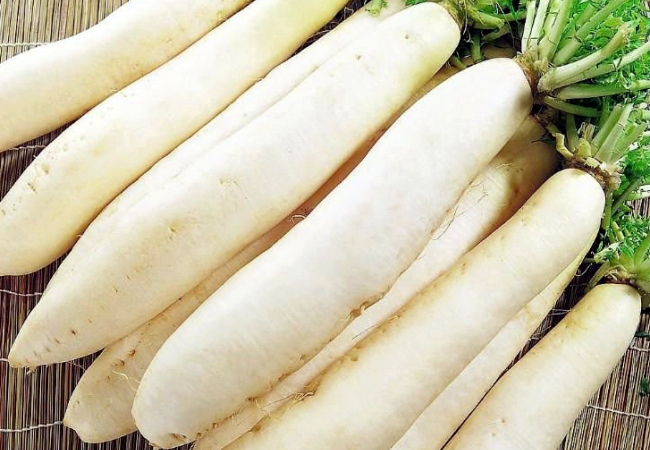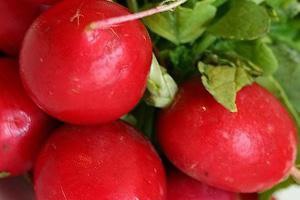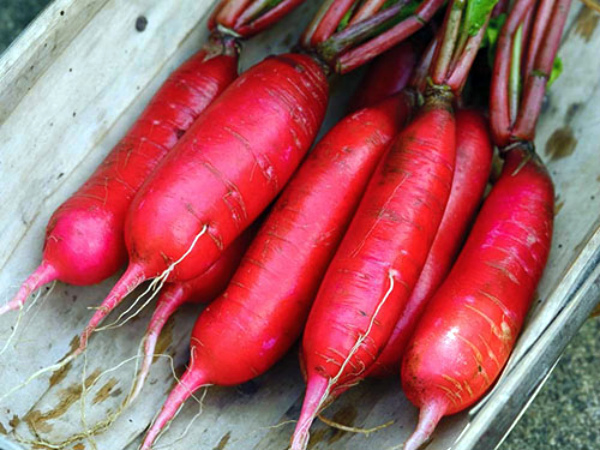Top best varieties of radish for outdoor use
Content
Early ripening fruits
Early ripening fruits are suitable for both unprotected and greenhouse soil. The main advantage is the shortest ripening period for root crops.
"Radish 16" is intended for early forcing in unprotected soil. It is allowed to grow vegetables in specially prepared film shelters. The high-yielding variety is characterized by its rounded shape, which turns bright red during ripening. The pulp is juicy and tender, becomes white. During cultivation, the fruits do not crack or shoot. Ripening time: 16 days.
"Heat" is suitable for early forcing (open, protected soil is suitable). Also, the vegetable is suitable for winter sowing. In this case, the seeds must be laid to a depth of 3 cm. The peculiarity of the root crop: dense juicy pulp, neutral taste (weakly sharp), takes on a smooth, rounded shape and raspberry hue in the process of growth. Ripening time: 20 days.
"Presto" - the root vegetable takes on a bright red hue, rounded shape and juicy flesh in front of the cathedral. Pesto fruits have the most aesthetic presentation in comparison with other varieties of radish. The variety does not shoot or crack during cultivation. Ripening time of the vegetable: 16 days.
Early fruits
The use of early varieties is typical for greenhouses, where ripening and harvesting occurs at approximately the same time intervals (for further use of the soil for other varieties of vegetable crops). Gardeners use seeds of early fruits mainly in summer.
"Borka" in the process of ripening acquire a red tint. The tip of the root vegetable is colored white. Fruits are medium in size (about 30 grams), with white juicy pulp. The pulp is spicy, leaves a pleasant sweetish aftertaste.
"Zlata" has the ability to form yellow, rounded fruits. The vegetable reaches a mass of 24 grams. The pulp becomes white, it is juicy, tender, with a neutral (weak) taste. The advantage of Zlata seeds is their high yield, regardless of external weather conditions. The variety is especially resistant to high temperatures.
“Quarta” is a very small radish (the maximum weight of a vegetable is 15 grams). The best period for planting: late summer (in unprotected soil or in a greenhouse). The resistance of the root crop to "flowering" and high productivity are noted. The peculiarity of "Quarta": the root crop is not completely immersed in the ground, and not ⅔, which makes it easier to harvest.
Mid-season fruits
The use of mid-season fruits is most common for several reasons:
- optimal ripening times;
- high level of productivity;
- pronounced taste.
"White nights" may have got its name from the fact that the rind and pulp of the root vegetable becomes white. The seeds of the variety give plants that are resistant to "flowering", as well as massive roots that can reach 5 centimeters in diameter. The pulp is dense, spicy, leaves a sweet aftertaste. A feature of the vegetable is its long shelf life, regardless of external weather conditions.
"Saksa" is a Russian variety of folk selection, created specifically for growing in unprotected soil.
Rounded red roots reach a weight of 15 grams. The pulp is tender, juicy, neutral taste, without bitterness. The disadvantage of this vegetable is its short shelf life. Unfortunately, roots quickly lose their elasticity and taste, become flabby and give off bitterness.
"Resistant" is a type of vegetable that is resistant to "flowering". It has an attractive aesthetic appearance: red roots of a raspberry hue. Vegetable sizes can vary (allowable weight - from 12 to 23 grams).
Late fruits
The ripening period of root crops is increased in comparison with the previous varieties of vegetables. But at the same time, later varieties give a much larger yield.
"Rumposh" has a characteristic feature - it has a white pulp and rind. The vegetable takes on an oblong, elongated shape (similar to a spindle). The pungency of the root crop is moderate. The advantage of the Rumposh radish: the most developed resistance to shooting.
"Würzburg" is one of the most productive varieties of vegetables. Gardeners prefer the Würzburg radish, calling it the best vegetable for unprotected soil. A feature of the fruit is its versatility. Fruits can be grown in the open field in the late period or in greenhouse conditions (under the film) in the early period. The vegetable grows massive, large, takes on a raspberry-red hue.
"Dungan (12/8)" is resistant to droughts, does not shoot, is capable of reaching a weight of 8 grams. On the peel, which takes on a raspberry color, white or pink grooves are noticeable (located across the root crop). The pulp is spicy and has a sweet aftertaste. The maximum allowable storage temperature for Dungansky (12/8) radish is 4 ° С.
"Red giant" is capable of reaching a weight of 120 grams, which makes the root crop one of the most massive and largest.
This radish takes the shape of a cylinder, turns bright red (white flesh). Suitable for storage in the cold season (late autumn - winter), so it is recommended to sow seeds in July or August.
General recommendations:
- select radish seeds based on the geographic area in which you will be planting. Take into account the presence of diseases, pests, soil features in order to choose the most optimal variety of vegetables;
- the most suitable period for planting a root crop: the first summer month (before the heat sets in);
- before planting, it is necessary to sort the seeds (select the freshest and largest). Soak them in a sodium chloride solution (about 5%). Those that remain at the bottom, use for sowing (after rinsing under running water). It is permissible to additionally soak the seeds in a special microelement solution to accelerate ripening, improve taste and provide additional protection against diseases;
- Find a garden bed that will be optimally lit by sunlight. Make sure that the soil is fertile, with enough fertilizers needed;
- strictly follow the instructions on the back of the packaging in which the seeds were purchased. Each type of root crop requires special care and sowing rules. Follow the technology carefully for maximum results;
- use additional preparations to protect and nourish vegetables.
Video "The best varieties of radishes"
This video will show you what grows from the seeds of popular radish varieties so you can decide which radish to plant.






